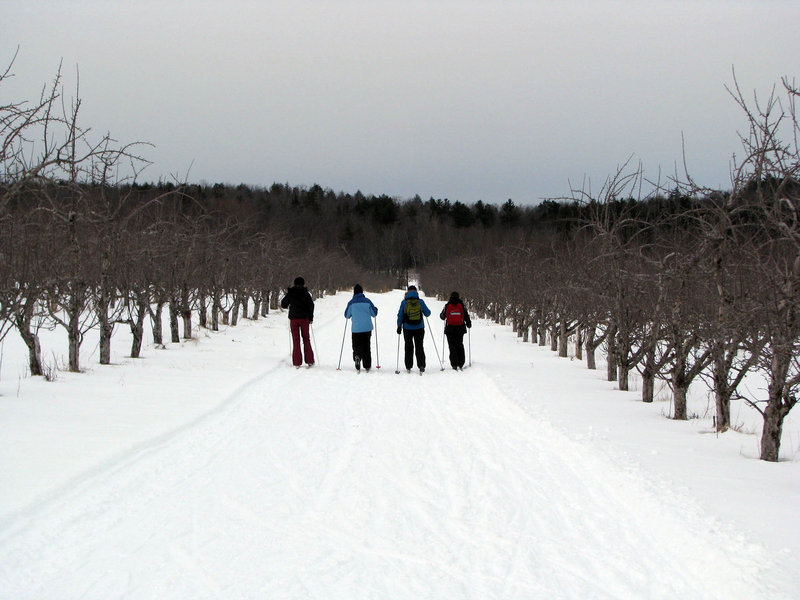Snow divides people.
When the fallen fluff gathers on streets, fields and front steps, people typically have one of two disparate reactions. They either rage against it, wielding shovels and cursing nature from the driveway, or they revel in it, on skis and sleds and snowshoes.
It’s a winter-specific “fight or frolic” response.
Psychologically speaking, the revelers tend to fare better. They suffer less from weather-related hostility (which tends to spill out at the office, to the chagrin of the department printer, which takes the brunt of it).
But making the leap from snow foe to devotee can be daunting for the snowphobic.
Ice skating is swell, but you’re hindered by the pond boundaries while the scenery repeats itself with every go-around.
Downhill skiing is adventurous, but there’s that whole “downhill” thing to contend with.
Cross-country skiing, however, is an ideal blend of scenic adventure and ease of use, sans the high-speed hills.
Consider it the gateway snow sport — an activity that everyone in the family can master, that can be done just about anywhere and doesn’t require participants to pawn grandma’s heirloom jewelry to afford it.
A few winters ago, when I realized that knitting a king-sized duvet cover was not a feasible way to spend the winter, I gave cross-country skiing at try.
I tagged along with a group of Portland women to a cross-country skiing Walk-On Adventure through L.L. Bean in Freeport. The $15 adventures enable interested skiers to try a sport on for size, complete with equipment, instruction and a cup of hot chocolate.
Experienced instructors Tom Boston and Suzanne Blackburn had walked us through the basics (i.e., how to lock your boot into the ski, how to hold the poles) before we bundled up and headed outside.
No one fell putting on her skis (the falling would come later) but Boston prepared us for the inevitable with a quick demonstration of the “turtle.”
The turtle is a practical, though less-than-graceful, method a fallen skier can use to right herself. It requires the skier, while on her back, to grab onto the tips of her skis and then tip her body sideways. Once there, a skier can use her hands to push herself up again.
As if the fall wouldn’t be embarrassing enough.
Once we’d gotten the feel for maneuvering with those long sticks on our feet, we headed to an open field adjacent to the training lodge. The groomed trail kept to the tree line and away from the wind. Our skis slid in parallel tracks cut into the snow by previous skiers, like small toboggan runs that pitted left ski against right in a race to the finish.
When our cross-country skiing confidence was high, we ditched the groomed trail for the woods. The accommodating ski tracks gave way to icy patches and a scattering of brown leaves. And people began falling down. It wasn’t so much the terrain as a human reflex. When you’re standing unsteadily on a pair of skis and someone in close proximity falls down, and you now have the notion of falling in your head, it does something awful to your nerves.
People began dropping for no apparent reason. “We’re like spooked horses,” I recall someone saying.
As it turns out, falling isn’t all that bad. Not bad enough to have hindered an excursion last weekend to Five Fields Farm in Bridgton.
The farm boasts 27 kilometers of trails and connects with the adjacent Loon Echo Land Trust on Bald Pate Mountain. And it has hills. It’s teeming with them. My colleague Wendy Almeida, who cross-country skis frequently with her family, warned me that she considered the trail system at Five Fields Farm to be for “moderate to advanced skiers.”
I opted to join her and her two daughters there anyway.
There’s a trail map available at the warming hut, where skis, boots and poles can also be rented and where a $10 trail use fee can be dropped into an old cigar box on the table.
The groomed trails close to the warming hut loop around the wintry remnants of an apple orchard, where the bare trees raise their crooked branches to the heavens as if to say, “Bring spring back!”
This is the same location where the annual Mushers Bowl is taking place this weekend, which means the trails are busy with skis, sleds and dogs. But on any other non-mushing afternoon, there’s little noise aside from the rhythmic glide of right ski, left ski, right ski, left ski.
At an elevation of 850 feet, the views from Five Fields Farm aren’t too shabby either.
Since Almeida and her daughters were already well-versed in the trail system here, we decided to throw caution to the wind and ski to the hills. I did know the turtle, after all, should anything go awry.
Avid downhill skiers might scoff at the sight of these timid declines, but on cross-country skis, they’re still a bit of a thrill. The climbing up, on the other hand, is exhausting. Though it does offer the opportunity to “duck walk,” angling your skis outward so the edges dig into the snow with each step. Try skiing up and you’ll find yourself gathering speed in reverse.
We sailed down hills one at a time, to prevent a collision, allowing ourselves to coast to a gentle stop before continuing our relaxed cadence on the straightaways. It wasn’t hard to get the hang of it.
And every few minutes we stopped to let our eyes linger on the motionless trees and the motionless snow, while our exhalations made small puffs of smoke in the cold air.
It was enough to make a snow devotee out of the staunchest snow detractor.
Staff Writer Shannon Bryan can be contacted at 791-6333 or at:
sbryan@mainetoday.com
Send questions/comments to the editors.



